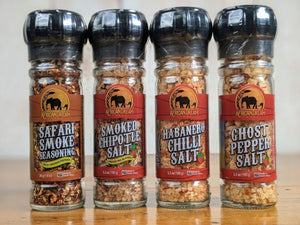Exploring the African Ghost Pepper
Apr 21, 2023
Ghost peppers, also known as Bhut Jolokia, are a type of chili pepper that originated in India. They are renowned for their intense heat and unique ghost pepper flavor, which has earned them a reputation as one of the hottest peppers in the world. In this blog post, we’ll explore the history, nutritional value, benefits, and risks of consuming ghost peppers, with a special focus on the unique African ghost pepper.
History and Origin of Ghost Peppers
Ghost peppers have been grown in India for centuries, particularly in the northeastern states of Assam, Nagaland, and Manipur. However, they only gained worldwide attention in the early 2000s when a farmer named Anandita Dutta Tamuli discovered a pepper with an extraordinary heat level while cultivating traditional chili peppers.
Ghost peppers quickly gained popularity in India and were used to add heat to a wide variety of dishes, including curries, chutneys, and pickles. It wasn’t until 2007 that they gained international attention when they were awarded the Guinness World Record title of “World’s Hottest Chilli Pepper” in 2007. Since its rise to fame in the early aughts, hotter chillis have shown up to steal the ghost pepper’s crown. Ranked currently as 9th, the ghost pepper is no longer the world’s spiciest chilli.
Even so, it has retained its celebrity status, remaining the hot topic of viral videos and a sought-after ingredient in some of the world’s best international hot sauces. Decades later, the beloved pepper has developed a cult following, with countless Twitter accounts, websites and YouTube channels dedicated to all things ghost pepper.
Why Is Ghost Pepper So Popular Today?
Even after being dethroned as the hottest chili in the world, ghost pepper still holds a legendary status. Its balance of flavor and fire makes it ideal for everything from hot sauces and marinades to spicy snacks and even cocktails. The rise of chili challenges and spicy food trends has also helped push ghost peppers further into the spotlight. Search terms like “ghost pepper flavor” and “ghost pepper benefits” are trending as people explore how to enjoy the heat while reaping possible health advantages.
Nutritional Value of Ghost Peppers
Ghost peppers are packed with vitamins and minerals that are essential for maintaining a healthy diet. They are an excellent source of vitamin C, vitamin A, and potassium. Vitamin C is crucial for maintaining a healthy immune system, while vitamin A is essential for healthy vision, skin, and hair. Potassium is important for regulating blood pressure and maintaining proper hydration.
Ghost peppers also contain capsaicin, which is responsible for the pepper’s spicy taste. Capsaicin has been shown to have anti-inflammatory properties and may also help to boost metabolism and reduce pain.
SEE ALSO: Is Hot Sauce Healthy?
Ghost Pepper Health Benefits Backed by Science
There’s a growing body of research surrounding ghost pepper benefits, particularly those tied to capsaicin. This compound may aid in digestion, improve circulation, reduce inflammation, and even trigger endorphin release, giving you that “spicy high.” While the health benefits of ghost pepper are still being studied, it’s clear that when consumed in moderation, this super-hot chili could be more than just a flavor booster.
Benefits and Risks of Consuming Ghost Peppers
Consuming ghost peppers in moderation may have several potential health benefits. Some research suggests that capsaicin may help to reduce inflammation, alleviate pain, and boost metabolism. Additionally, the high levels of vitamin C and potassium in ghost peppers may help to support a healthy immune system and regulate blood pressure.
However, it’s important to consume ghost peppers in moderation, as their extreme heat level can cause digestive issues such as stomach pain, cramps, and diarrhea. Handling ghost peppers with care is also important, as the capsaicin can cause skin irritation and burns.
Types of Ghost Peppers

There are several different types of ghost peppers, each with their own unique characteristics. Here are some of the most popular types of ghost peppers:
Bhut Jolokia: This is the most well-known type of ghost pepper and is the one that gained international recognition as the world’s hottest chili pepper. It has a fruity, slightly sweet flavor and a heat level that ranges from 800,000 to over 1 million Scoville heat units (SHU).
Chocolate Bhut Jolokia: This variety of ghost pepper is similar to the Bhut Jolokia but has a darker color and a slightly different flavor profile. It has a heat level that ranges from 800,000 to over 1 million SHU.
Peach Bhut Jolokia: This type of ghost pepper has a peach-colored exterior and a slightly milder heat level than other varieties, ranging from 600,000 to 800,000 SHU. It has a fruity, slightly sweet flavor with hints of citrus.
White Ghost Pepper: This is a relatively new variety of ghost pepper that has a white exterior and a heat level that ranges from 800,000 to 1 million SHU. It has a slightly sweeter and more floral flavor profile than other ghost peppers.
Yellow Ghost Pepper: This variety of ghost pepper has a bright yellow exterior and a slightly milder heat level than other types, ranging from 500,000 to 800,000 SHU. It has a slightly fruity, citrusy flavor with hints of sweetness.
Each type of ghost pepper has its own unique flavor profile and heat level, which makes them a popular ingredient for adding heat and flavor to a wide variety of dishes.
Ghost Peppers in Modern Cuisine
Today, ghost peppers aren’t just for daredevils — they’re being incorporated into gourmet cuisine, artisan sauces, and even desserts. Chefs are learning how to harness the ghost pepper flavor in subtle ways: think chocolate truffles with a hint of ghost chili, or mango salsas with a touch of bhut jolokia heat. For those who want to explore high-heat recipes without the intense burn, sauces like Ghost Peri-Peri deliver a flavorful yet manageable kick.
The African Ghost Pepper: Flavor and Heat
The African ghost pepper is all about upfront flavor and slow-burning spice. Despite its rockstar reputation as an ultra-hot chilli, its first bite is deceivingly sweet, boasting strong fruity notes and an initially subtle heat. The pepper’s mild, flavorful hints last for around 30-45 seconds before building into a powerful, mouth-searing burn. As the heat intensifies, expect to experience sweating, watering eyes and even shortness of breath.
While the ghost pepper no longer holds the crown as world’s hottest chilli, its spice is certainly nothing to bat an eye at. In fact, its heat is so powerful that it has been used in both elephant deterrents and military-grade smoke bombs. But don’t let that scare you off! Sure, the ghost pepper is nothing short of an inferno when consumed raw. Cook it into a sauce or a curry, however, and you’ll be met with a highly palatable (yet still powerful) heat that allows the pepper’s unique flavors to shine through a little stronger.

Where does the African Ghost Pepper Grow?
When it comes to growing conditions ghost peppers are a picky bunch. Cultivated originally in India, these firecrackers demand a delicate combination of heat and humidity to survive. While ghost peppers struggle in many environments across the globe, Africa’s unique soil and climate offer the perfect conditions for them to thrive.
In Africa, the African Ghost Pepper can be found growing in various regions, including Mozambique, Zimbabwe, South Africa, and Kenya. The pepper plants typically grow to around 3 feet tall and produce small, cone-shaped fruits that range in color from green to red, depending on their maturity.
The African Ghost Pepper is known for its ability to grow well in hot, dry environments with well-drained soil. It can also tolerate a range of soil types, from sandy to loamy. In many African communities, ghost peppers are grown using traditional farming methods and are often intercropped with other crops, such as corn or beans.

The unique growing conditions in Africa, combined with traditional breeding practices, have resulted in African ghost peppers with a distinct flavor and aroma. The peppers are often used in local cuisines to add heat and flavor to stews, curries, and other dishes. They are also popularly used in the production of hot sauces and condiments, which are exported to international markets.
What Makes the African Ghost Pepper Unique?
The African ghost pepper stands out from its Indian cousin thanks to Africa’s unique soil composition and traditional farming methods. Grown under the African sun, this variety often has deeper earthy tones and a longer-lasting heat. While bhut jolokia pepper typically delivers sharp heat upfront, the african ghost pepper offers a slow-building intensity, making it ideal for hot sauces where flavor complexity matters just as much as firepower.
For generations, local breeding practices and distinctive climate conditions have uniquely influenced the African ghost pepper, setting it apart from its international variations. With an unmistakable aroma and flavor, the chilli has become a rich staple of the continent’s traditional cuisines and a favorite ingredient in some of the world’s best international hot sauces.
SEE OUR AFRICAN GHOST PEPPER SAUCE!
Overall, the African Ghost Pepper’s ability to grow in Africa’s unique climate and soil conditions has resulted in a flavorful and distinctive pepper that is a valuable crop for local farmers and a sought-after ingredient for chefs and hot sauce enthusiasts worldwide.
Traditional Uses of Ghost Chilli
When raw, the African ghost pepper is shockingly hot. When cooked, however, the chilli’s heat softens, elevating its flavor while reducing its burn to a palatable—yet still powerful—sizzle. It’s popular in both hot sauce recipes as well as many of the continent’s traditional spicy recipes.
Despite its heat, the sweltering African ghost pepper’s rich flavor and fruity undertones make it an excellent addition to curries, stews and marinades. Its unique, balanced palate is also what makes it shine as the star ingredient of our Ghost Pepper Salt as well as our heavy-hitting, tongue-searing African Ghost Pepper Sauce—an authentic African hot sauce intended only for true hot sauce addicts.
Of course, for those who crave the ghost pepper’s distinctive flavor but shy away from extreme heat, there’s also the milder Ghost Peri-Peri sauce—a tangy, flavorful African hot sauce that makes an ideal go-to hot sauce for eggs, sandwiches, pizza and chicken.
How to Enjoy Ghost Peppers Without Overheating
If you’re new to the world of ghost peppers, ease into it. Start with products like Ghost Peri-Peri Sauce, which delivers that signature flavor at a more manageable heat level. Sprinkle a little ghost pepper salt on grilled corn or add a drop of African ghost pepper sauce to a tomato-based pasta. These small touches let you explore the flavor while building your heat tolerance naturally.
Ghost peppers are a popular ingredient in many traditional cuisines worldwide, especially in India and other parts of South Asia. Here are some traditional uses of ghost chili in culinary practices:
- Spice up Curries and Stews: Ghost chili is often used in curries and stews to add heat and flavor to the dish. In India, it is a popular ingredient in dishes like vindaloo, a spicy curry made with meat or vegetables, and chutneys, which are spicy condiments.
- Pickling: Ghost chili is often used in pickling as it can add a fiery kick to the preserved food. In India, it is common to pickle ghost chili with other vegetables like carrots, radish, and cauliflower.
- Spice Blends: Ghost chili is a common ingredient in spice blends, especially in South Asian cuisines. In India, it is often used in garam masala, a blend of ground spices used in many dishes.
- Medicinal Purposes: In some cultures, ghost chili is also used for its medicinal properties. It is believed to have pain-relieving properties and is sometimes used topically to alleviate muscle and joint pain. It is also believed to aid in digestion and boost metabolism.
Are Ghost Peppers genetically modified?
Ghost peppers are not genetically modified. They are a naturally occurring cultivar of the Capsicum chinense species, which is native to northeastern India and neighboring regions. The ghost pepper plant was traditionally grown in the Indian states of Assam, Nagaland, and Manipur and has been cultivated for centuries.
While there have been attempts to hybridize the ghost pepper with other pepper species to create new cultivars, these techniques do not involve genetic modification. Instead, they rely on traditional breeding methods, such as cross-pollination and selection, to create new pepper varieties with desired characteristics.
It is important to note that the production of genetically modified organisms (GMOs) is highly regulated in many countries, including the United States, where the use of genetically modified crops is subject to stringent oversight by government agencies such as the U.S. Department of Agriculture (USDA) and the Food and Drug Administration (FDA). As of now, there are no commercially available GMO varieties of ghost peppers.
Ghost Pepper vs Carolina Reaper

Ghost peppers are not genetically modified. They are a naturally occurring cultivar of the Capsicum chinense species, which is native to northeastern India and neighboring regions. The ghost pepper plant was traditionally grown in the Indian states of Assam, Nagaland, and Manipur and has been cultivated for centuries.
While there have been attempts to hybridize the ghost pepper with other pepper species to create new cultivars, these techniques do not involve genetic modification. Instead, they rely on traditional breeding methods, such as cross-pollination and selection, to create new pepper varieties with desired characteristics.
It is important to note that the production of genetically modified organisms (GMOs) is highly regulated in many countries, including the United States, where the use of genetically modified crops is subject to stringent oversight by government agencies such as the U.S. Department of Agriculture (USDA) and the Food and Drug Administration (FDA). As of now, there are no commercially available GMO varieties of ghost peppers.
Ghost Pepper vs Jolokia Pepper: Is There a Difference?
Some people use the terms ghost pepper and jolokia pepper interchangeably — and they’re not wrong. “Jolokia” is part of the pepper’s original name: Bhut Jolokia. In Hindi, “bhut” means ghost, which is how the name ghost pepper came about. Over time, global foodies shortened the term, but bhut jolokia pepper still refers to the same species — Capsicum chinense. Whether you call it ghost, bhut, or jolokia, it brings the same unforgettable fire.
Is Ghost Chilli the Same as Ghost Pepper?
Yes — ghost chili is just another name for ghost pepper. In fact, around the world, this chili goes by many names: bhut jolokia, jolokia pepper, ghost chili, and ghost pepper. Each term refers to the same fiery cultivar of Capsicum chinense. These varied names reflect the pepper’s global appeal and different cultural uses, but the heat remains unmistakably intense across the board.
Frequently Asked Questions
What is a ghost pepper?
A ghost pepper (Bhut Jolokia) is a hot chili pepper that is widely used in traditional cuisines around the world, particularly in India and South Asia. It is known for its unique fruity and slightly sweet flavor, as well as its intense heat, with an average Scoville rating of around 1 million units.
How hot is a ghost pepper?
Ghost peppers are extremely hot, with an average Scoville rating of around 1 million units. This makes them one of the hottest peppers in the world.
How do I handle ghost peppers safely?
When handling ghost peppers, it’s important to wear gloves and avoid touching your eyes or other sensitive areas. It’s also a good idea to work in a well-ventilated area to avoid inhaling the capsaicin fumes.
Can I eat a ghost pepper raw?
While it’s possible to eat a ghost pepper raw, it’s not recommended due to their extreme heat. Instead, they are commonly used in cooking, either dried or fresh, to add heat and flavor to dishes.
What dishes can I use ghost peppers in?
Ghost peppers are commonly used in traditional Indian and South Asian cuisines, as well as in hot sauces, chutneys, pickles, and marinades. They can also be used to add heat and flavor to a variety of dishes, including soups, stews, curries, and stir-fries.
Are ghost peppers genetically modified?
No, ghost peppers are a naturally occurring cultivar of the Capsicum chinense species and are not genetically modified.
Can I grow ghost peppers at home?
Yes, ghost peppers can be grown at home in a warm and sunny location, such as a greenhouse or a sunny windowsill. They require well-draining soil and regular watering to thrive.
Are there any health benefits to eating ghost peppers?
Capsaicin, the active compound in ghost peppers, has been shown to have a range of potential health benefits, including pain relief, improved digestion, and lower cholesterol levels. However, consuming too much capsaicin can also cause digestive issues, so it’s important to consume ghost peppers in moderation.
In conclusion, ghost pepper (Bhut Jolokia) is a hot chili pepper that is widely used in traditional cuisines around the world, particularly in India and South Asia. It is known for its unique fruity and slightly sweet flavor, as well as its intense heat, with an average Scoville rating of around 1 million units. Ghost pepper requires specific growing conditions, with hot and humid climates being ideal, and is naturally occurring cultivar of the Capsicum chinense species.
In contrast, the Carolina Reaper is a smaller and wrinkled hybrid pepper created through selective breeding, with an average Scoville rating of over 1.5 million units, making it the hottest pepper in the world. Despite their differences, both peppers are commonly used in various cuisines and hot sauce products around the world to add heat and flavor to dishes.
Growing ghost peppers in Africa has many benefits, including providing a sustainable source of income for local farmers, preserving the natural environment, and producing a high-quality crop with a unique flavor. Additionally, the distinct climate and soil conditions in Africa make it an ideal region for ghost pepper cultivation, leading to the development of unique African ghost pepper varieties with their own distinct flavor profile.




